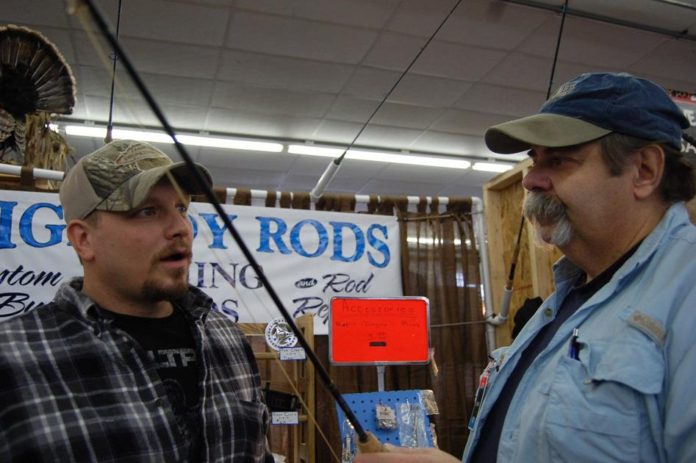It’s no secret trout can be very finicky feeders, and with the season under way and streams warm throughout the late spring, the height of the fly-fishing season is happening for veteran Pennsylvania fly anglers and for those wanting to learn more about the sport.
As anglers become more proficient, many learn the advantages of having a custom rod built to serve their individual style. An entry-level fly rod like those built by Randy Emerich of BigDady Rods in Pottsville are comparable in price to many brand name rods.
With trout spending large amounts of time feeding on different stages of aquatic insects within streams, such as mayflies, stone and caddis flies, a variety of flies are needed for what trout might be taking with the season in full swing. Many of the nymphs trout feed on endure size and color changes as the aquatic insects grow to adulthood.
This means that the nymphs in the stream bottoms are in a constant state of change as each day puts them closer to the time when they will emerge through the surface of the water as adult duns, ready to mate and repopulate the stream with new eggs that will ensure the existence for the future. Generations of fly anglers have tried to figure out if there is a magic fly and what flies will work the best on certain waters.
Truth is, this is easier said than done and it all comes down to learning the food preferences that the trout have at different times and being prepared to change flies and presentations as the conditions dictate. With trout having a wide range of aquatic insects at all maturity stages in the water to choose from, the ability to tie flies that can imitate these maturation changes will help anglers have an advantage.
Having a well-stocked fly box with flies tied to imitate the different insect species that trout commonly see and feed on, from the nymph or larva stage to spinners, can prepare the fly fisher for almost any situation that is likely to be encountered. Hendricksons, Blue-Winged Olives, March Browns and sulphur hatches from the mayfly genus are some of the most popular of our area and often entice trout.
Not to be overlooked, tying flies such as streamers that can imitate a minnow or a crustacean can also be very effective. For this reason, it is best to tie a variety of different flies from the different hatches that are found when on the water.
Not to be overlooked are flies such as the pheasant-tail nymph that can imitate many different species of mayfly nymphs in Pennsylvania. Tying flies allows the angler to not rush and to tie the number of flies that would be needed for the season.
Whether your preference is nymph fishing or dry flies or a combination of both, it is important to become familiarized with the aquatic insects on the streams likely to be fished. Fish tend to key on what is most available to them at the time and a big part of the fun is trying different patterns and making adjustments to see what works.
Where you fish and when you fish can play a big part in the assortment of flies that you could tie and have available. Certain streams seem to have different primary hatches and the time of the year that is fished can dictate the size and shape and color of the flies that will be most effective.
Trout spend a lot of time looking over what is coming down to them in the current and having flies ready that look like what they see hatching in the stream can make all of the difference. Fly tying also helps anglers become better students of the outdoors by focusing on details that can make the imitation fly look and move like a natural coming down in the current.
Just before a Blue-Wing Olive nymph transforms to a newly emerged dun, the back of the nymph starts to go through a slight color transformation as the area turns a few shades darker. Either natural material such as fur or even a wrapped feather or synthetic man-made materials can be used to achieve these color changes.
In addition, fly tiers also often look to create the appearance of gills along the abdomen or to tie in the exact appearance of a tail and make adjustments that will make for more realistic movement in the water. It doesn’t matter how long a person has tied flies or fly fished, one of the most satisfying and exciting experiences in the sport is to land a trout on a fly that the angler tied at their own vice.
For information on custom fly rods by Randy Emerich, contact BigDady Rods at www.bigdadyrods.com, call 570-622-1252 or make an appointment to visit the shop at 1200 Seneca St., Pottsville. Information about fly fishing and fly tying is available by visiting the Pennsylvania Fish and Boat Commission website at www.fishandboat.com.
Credit: Source link





























